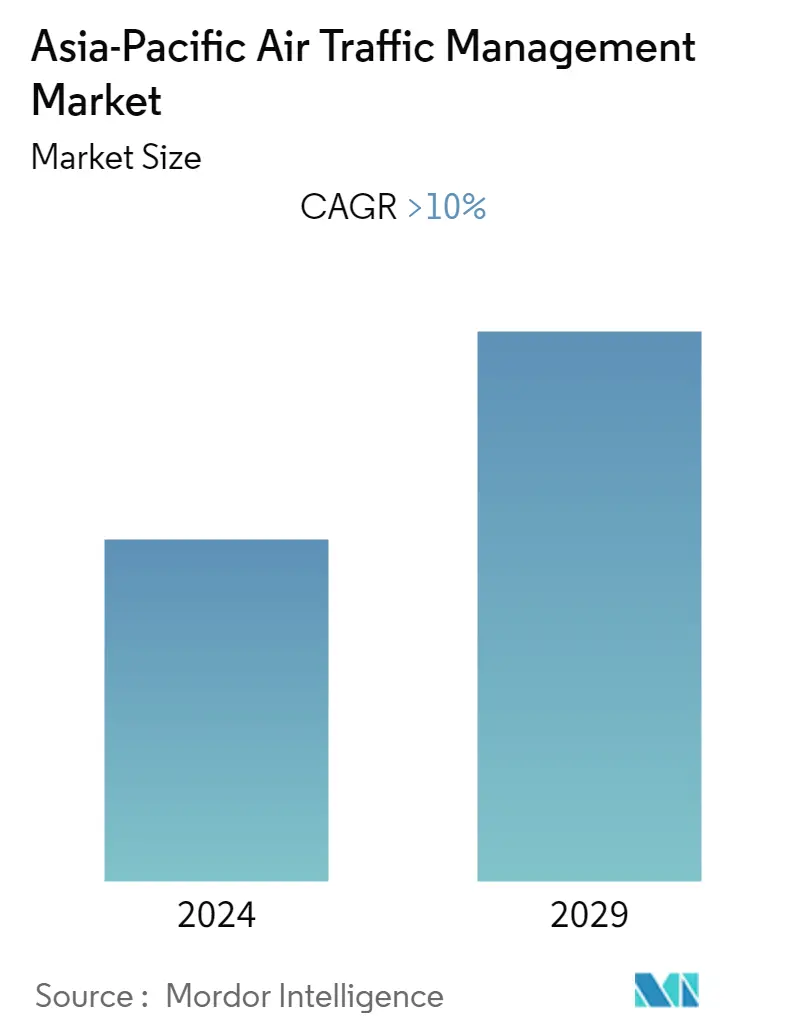Market Size of Asia-Pacific Air Traffic Management Industry

| Study Period | 2020 - 2029 |
| Base Year For Estimation | 2023 |
| Forecast Data Period | 2024 - 2029 |
| Historical Data Period | 2020 - 2022 |
| CAGR | 10.00 % |
| Market Concentration | Low |
Major Players
*Disclaimer: Major Players sorted in no particular order |
APAC Air Traffic Management Market Analysis
The Asia Pacific air traffic management (ATM) market is anticipated to register a CAGR of more than 10% during the forecast period.
- The aviation sector across the Asia Pacific was severely impacted due to the COVID-19 pandemic. The government imposed strict regulations to control the spread of coronavirus, leading to supply chain disruptions, the shutdown of manufacturing plants, labor shortages, etc. The aviation sector in the Asia-Pacific faced challenges due to reduced air traffic and the shutdown of airport operations. The market showcased a strong recovery from the second half of 2020 due to increased air passengers and reduced government restrictions.
- The growth in the Chinese and Indian markets is projected to be the most significant driver for the Asia-Pacific air traffic management market. The rapid growth in passenger traffic in Asia-Pacific is attracting investments toward the market as airports increase their passenger and flight handling capacities in tandem with the increasing passenger influx.
- With the positive outlook of the aviation industry in Asia-Pacific in the next 10 years, airlines are increasing their fleet size to offer their services to more passengers by procuring more aircraft and adding more routes. This is increasing the number of flights to be handled by airports. As airspaces become busier, the necessity for better airspace management is increasing. In addition, the increasing emphasis on the modernization of the old ATM infrastructure is also driving the growth of the market in Asia-Pacific.
APAC Air Traffic Management Industry Segmentation
Air traffic management (ATM) comprises all the systems that assist the aircraft from its departure from an airport to its landing at a destination airport, including the transit phase.
The Asia Pacific air traffic management market is segmented by domain, component, and country. By domain, the market is segmented into air traffic control, air traffic flow management, and aeronautical information management. By component, the market is divided into Hardware and Software. By geography, the market is segmented into China, India, Japan, South Korea, and the rest of Asia-Pacific.
The market sizing and forecasts have been provided in value (USD million) for all the above segments.
| Domain | |
| Air Traffic Control | |
| Air Traffic Flow Management | |
| Aeronautical Information Management |
| Component | |
| Hardware | |
| Software |
| Country | |
| China | |
| India | |
| Japan | |
| South Korea | |
| Rest of Asia-Pacific |
Asia-Pacific Air Traffic Management Market Size Summary
The Asia-Pacific air traffic management market is poised for substantial growth, driven by the region's robust recovery from the COVID-19 pandemic's impact on the aviation sector. The resurgence in air travel and the easing of government restrictions have spurred increased passenger traffic, particularly in China and India, which are expected to be significant growth drivers. This surge in air traffic has led to heightened investments in expanding airport capacities and modernizing air traffic management infrastructure. As airlines expand their fleets and routes to accommodate the growing number of passengers, the demand for advanced airspace management solutions is becoming increasingly critical. The market is also witnessing a shift towards upgrading outdated ATM systems to enhance operational efficiency and safety.
The hardware segment of the market is anticipated to experience notable expansion, fueled by extensive airport construction and modernization projects across countries like China, India, Singapore, and Vietnam. These developments are accompanied by the replacement of aging equipment with advanced technologies to improve air traffic management operations. China's dominance in the market is underscored by its significant investments in aviation infrastructure and the ambitious plans of the Civil Aviation Administration of China to expand the country's airport network. The fragmented market landscape features numerous local and international players, including Adacel Technologies Limited, L3Harris Technologies Inc., and SITA, who are leveraging innovations such as artificial intelligence and smart digital towers to drive growth. Collaborative initiatives, like those between Bharat Electronics Limited and the Airports Authority of India, are expected to further enhance the region's ATM capabilities, offering new business opportunities for market participants.
Asia-Pacific Air Traffic Management Market Size - Table of Contents
-
1. MARKET DYNAMICS
-
1.1 Market Overview
-
1.2 Market Drivers
-
1.3 Market Restraints
-
1.4 Porter's Five Forces Analysis
-
1.4.1 Threat of New Entrants
-
1.4.2 Bargaining Power of Buyers/Consumers
-
1.4.3 Bargaining Power of Suppliers
-
1.4.4 Threat of Substitute Products
-
1.4.5 Intensity of Competitive Rivalry
-
-
-
2. MARKET SEGMENTATION
-
2.1 Domain
-
2.1.1 Air Traffic Control
-
2.1.2 Air Traffic Flow Management
-
2.1.3 Aeronautical Information Management
-
-
2.2 Component
-
2.2.1 Hardware
-
2.2.2 Software
-
-
2.3 Country
-
2.3.1 China
-
2.3.2 India
-
2.3.3 Japan
-
2.3.4 South Korea
-
2.3.5 Rest of Asia-Pacific
-
-
Asia-Pacific Air Traffic Management Market Size FAQs
What is the current Asia-Pacific Air Traffic Management Market size?
The Asia-Pacific Air Traffic Management Market is projected to register a CAGR of greater than 10% during the forecast period (2024-2029)
Who are the key players in Asia-Pacific Air Traffic Management Market?
Adacel Technologies Limited, SITA, Indra Sistemas SA, Leidos, Inc. and L3Harris Technologies, Inc. are the major companies operating in the Asia-Pacific Air Traffic Management Market.

